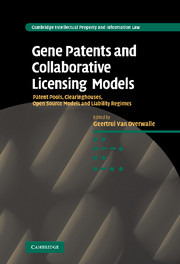 Gene Patents and Collaborative Licensing Models
Gene Patents and Collaborative Licensing Models Book contents
- Frontmatter
- Contents
- List of contributors
- Preface
- Foreword: Jean-Jacques Cassiman
- List of abbreviations
- Part I Patent pools
- Part II Clearinghouses
- 5 Clearinghouse mechanisms in genetic diagnostics. Conceptual framework
- 6 Case 3. The Global Biodiversity Information Facility (GBIF). An example of an information clearinghouse
- 7 Case 4. BirchBob. An example of a technology exchange clearing house
- 8 Case 5. The Public Intellectual Property Resource for Agriculture (PIPRA). A standard license public sector clearinghouse for agricultural IP
- 9 Case 6. The Science Commons Material Transfer Agreement Project. A standard licence clearinghouse?
- 10 Case 7. The collective management of copyright and neighbouring rights. An example of a royalty collection clearinghouse
- 11 Comment on the conceptual framework for a clearinghouse mechanism
- Part III Open source models
- Part IV Liability regimes
- Part V Different perspectives
- Part VI Summary and concluding analysis
- Index
- Titles in the series
9 - Case 6. The Science Commons Material Transfer Agreement Project. A standard licence clearinghouse?
from Part II - Clearinghouses
Published online by Cambridge University Press: 14 January 2010
- Frontmatter
- Contents
- List of contributors
- Preface
- Foreword: Jean-Jacques Cassiman
- List of abbreviations
- Part I Patent pools
- Part II Clearinghouses
- 5 Clearinghouse mechanisms in genetic diagnostics. Conceptual framework
- 6 Case 3. The Global Biodiversity Information Facility (GBIF). An example of an information clearinghouse
- 7 Case 4. BirchBob. An example of a technology exchange clearing house
- 8 Case 5. The Public Intellectual Property Resource for Agriculture (PIPRA). A standard license public sector clearinghouse for agricultural IP
- 9 Case 6. The Science Commons Material Transfer Agreement Project. A standard licence clearinghouse?
- 10 Case 7. The collective management of copyright and neighbouring rights. An example of a royalty collection clearinghouse
- 11 Comment on the conceptual framework for a clearinghouse mechanism
- Part III Open source models
- Part IV Liability regimes
- Part V Different perspectives
- Part VI Summary and concluding analysis
- Index
- Titles in the series
Summary
Introduction
Access to unique research resources, such as biological materials and reagents, is vital to the success and advancement of science. Many research protocols require assembling a large and diverse set of materials from many sources. Yet, often the process of finding and negotiating the transfer of such materials can be difficult and time-consuming. The ability to locate materials based on their descriptions in journal articles is often limited by lack of sufficient information about origin and availability, and there is no standard citation for such materials. In addition, the process of legal negotiation that may follow can be lengthy and unpredictable. This can have important implications for science policy, especially when delays or inability to obtain research materials result in lost time, productivity and research opportunities. These transactional barriers for material transfer may ultimately have more impact on the productivity of basic laboratory science than concerns related to patents or other intellectual property.
Science Commons, a project of Creative Commons, is a non-profit initiative that promotes policy and technology that remove unnecessary legal and technical barriers to scientific collaboration and innovation. Science Commons's Material Transfer Agreement Project seeks to reduce unnecessary barriers to the transfer and reuse of basic research materials and reagents by proposing a scalable and flexible infrastructure for searching, negotiation, and tracking.
The MTA Project is a prototype of what van Zimmeren calls a “standard licence clearinghouse”. However, material transfer agreements are not necessarily, or even frequently, about licensing patents.
- Type
- Chapter
- Information
- Gene Patents and Collaborative Licensing ModelsPatent Pools, Clearinghouses, Open Source Models and Liability Regimes, pp. 143 - 150Publisher: Cambridge University PressPrint publication year: 2009


